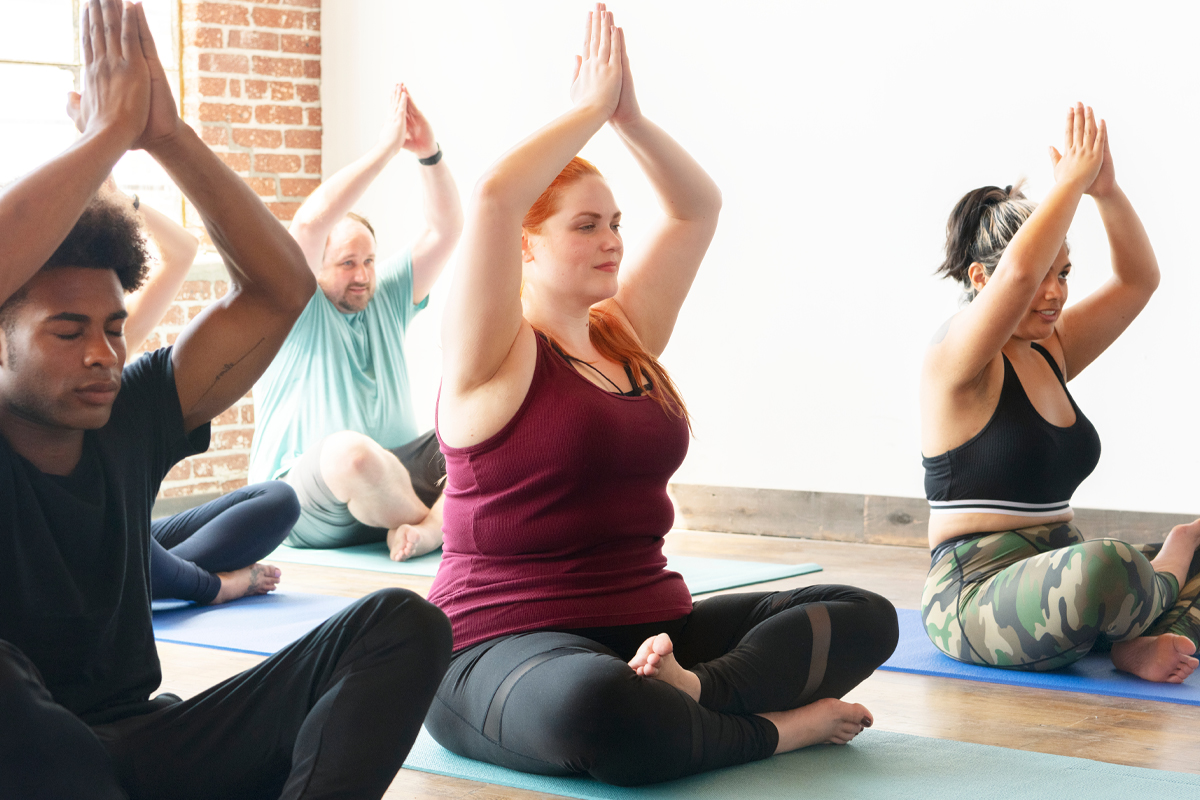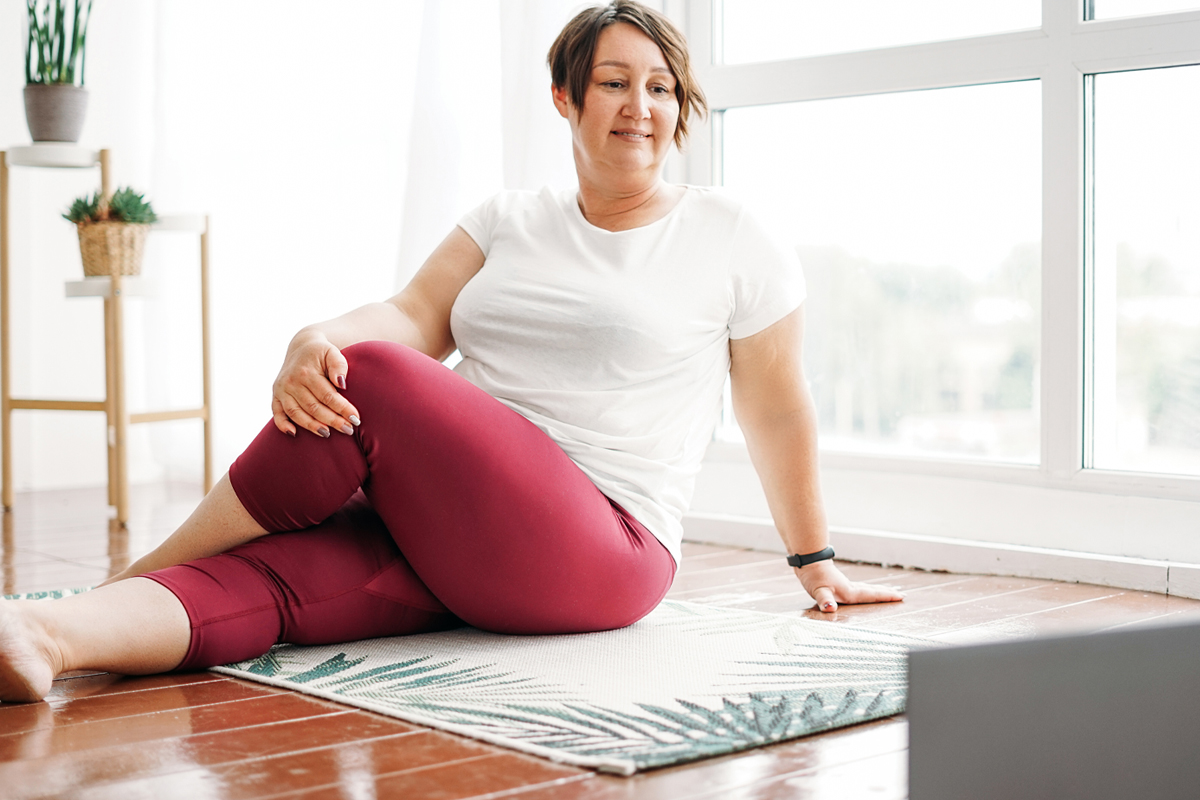Yoga and weight loss often go hand in hand. As a registered dietitian, I’ve seen firsthand how yoga can be a powerful part of a weight loss plan. Yoga strengthens both your body and mind, increases body awareness, and helps reduce stress levels. It also encourages a healthy diet and mindful eating, both important for sustainable weight loss.
While yoga itself does help burn calories, its other health benefits can significantly contribute to long-term, sustainable weight loss compared to fad diets.
In this blog, we’ll look at how yoga helps you lose weight safely and sustainably, explore different types of yoga, and emphasize the importance of a holistic approach.

What is Yoga and How Can It Help You Lose Weight?
Yoga is a practice that combines physical yoga poses, breathing exercises, and meditation. Its roots are in ancient India, but both traditional yoga and modern yoga have become popular forms of exercise and relaxation worldwide.
There are many different forms of yoga, each with its unique approach and benefits:
- Hatha Yoga: Known for its slower pace and basic poses, it’s great for beginners.
- Vinyasa Yoga: Involves a series of poses that flow smoothly into one another, often linked to breath.
- Restorative Yoga: Focuses on relaxation and recovery, using props to support the body in restful poses.
- Chair Yoga: Accessible for those with limited mobility, performed sitting on a chair or standing using a chair for support.
Other types of yoga include Ashtanga Yoga, Bikram, Iyengar, Kundalini, Yin, Power, Anusara, and Jivamukti yoga, each offering various benefits and challenges.
According to a study by the National Institute of Health, yoga can improve muscle strength and body flexibility, improve respiratory and cardiovascular function, aid in addiction recovery, reduce stress, anxiety, depression, and chronic pain, improve sleep patterns, and enhance overall well-being and quality of life.
While yoga helps you lose weight by improving physical strength, flexibility, and mental well-being, it’s not a magic solution.
The true value of yoga for weight loss lies in its ability to reduce stress, increase mindfulness, and promote overall health.
To maximize the benefits, it’s important to combine yoga with other healthy habits like a healthy diet, regular physical activity, and adequate sleep.

How a Regular Yoga Practice Can Help You Lose Weight
A consistent yoga practice offers several benefits that support your efforts to lose weight. Here are some key advantages:
- Improves Flexibility and Strength: Regular yoga practice enhances your body’s flexibility and builds muscle strength. This can improve overall fitness and make other physical activities easier. Increased muscle mass also boosts your metabolism, helping you burn more calories even at rest.
- Enhances Mental Well-being: Yoga promotes mental clarity and emotional stability. It helps you become more mindful and focused, which can support healthier eating habits and better lifestyle choices. Mindfulness developed through yoga can lead to a greater awareness of hunger and satiety cues, helping you make more conscious decisions about food.
- Reduces Stress: One of the most significant benefits of yoga is stress reduction. Lower stress levels can lead to better sleep, reduced emotional eating, and improved overall well-being, all of which contribute to losing weight. Stress hormones like cortisol can increase appetite and lead to weight gain, so reducing stress is crucial for maintaining a healthy weight.
- Supports Cardiovascular Health: Some forms of yoga, like Vinyasa and Power Yoga, provide a cardiovascular workout. These dynamic styles increase your heart rate and promote cardiovascular fitness, which is essential for overall health.
- Encourages a Balanced Lifestyle: Yoga often promotes a holistic approach to health, encouraging not just physical activity but also healthy eating, adequate rest, and mental well-being. This comprehensive focus can help you develop a more balanced and sustainable approach to losing weight.
Overall, yoga’s combination of physical and mental health, combined with the emotional benefits makes it an effective tool in a comprehensive plan to lose weight.
By integrating yoga into your routine, you can enhance your overall health, reduce stress, and support long-term weight loss success.
Different Types of Yoga for Weight Loss

Hatha Yoga and Its Benefits for Losing Weight
What is Hatha Yoga?
Hatha Yoga is a branch of yoga that focuses on physical postures and breathing techniques. It is known for its slower pace and simpler poses, making it an ideal starting point for beginners.
Practicing Hatha Yoga offers numerous health benefits, such as improved flexibility, strength, and mental well-being.
Using a yoga mat, you comfortably perform sitting and standing poses, which helps with stability and reduces the risk of injury. This practice not only provides a solid foundation for a healthy lifestyle but also supports long-term weight loss goals through mindful movement and stress reduction.
Benefits for Weight Loss
- Accessibility: Hatha Yoga is approachable for all fitness levels, making it easy for beginners to start and maintain a regular practice.
- Mindful Movement: This form of yoga emphasizes mindfulness and body awareness, helping practitioners connect with their bodies and recognize their physical limits and potentials.
- Stress Reduction: Hatha Yoga promotes relaxation and stress reduction, which can help prevent stress-related eating and weight gain.
Weight Loss with Vinyasa Yoga

What is Vinyasa Yoga?
Vinyasa Yoga involves a series of poses that flow smoothly from one to another, often coordinated with breath. It is known for its dynamic and fluid movements. This form of yoga utilizes body weight to transition through various poses, such as the mountain pose, and integrates various yoga practices to create a cohesive and challenging workout.
By engaging multiple muscle groups and maintaining continuous movement, Vinyasa Yoga effectively enhances strength, flexibility, and cardiovascular health.
Benefits for Weight Loss
- Cardiovascular Workout: The continuous flow of Vinyasa Yoga increases heart rate, providing a good cardiovascular workout that burns calories.
- Strength and Flexibility: This practice builds both strength and flexibility, contributing to overall fitness and increased muscle mass.
- Stress Reduction: Like other forms of yoga, Vinyasa helps reduce stress and promote mental clarity, supporting healthy lifestyle choices.
Restorative Yoga: A Relaxing Path to Weight Loss

What is Restorative Yoga?
Restorative Yoga focuses on relaxation and recovery, using props to support the body in restful poses held for extended periods. This form of yoga practices emphasizes deep relaxation and stress reduction, which can help individuals lose weight by alleviating stress-related eating.
Poses such as child’s pose are commonly used to promote comfort and relaxation. Incorporating Restorative Yoga into your routine complements other yoga practices and enhances overall well-being, making it an effective component of a holistic weight loss plan.
Benefits for Weight Loss
- Deep Relaxation: This practice helps reduce stress and promote deep relaxation, which can combat stress-related weight gain.
- Recovery: Restorative Yoga aids in muscle recovery and flexibility, making it an excellent complement to more intense workouts.
- Mindfulness: The slow, meditative nature of Restorative Yoga encourages mindfulness and body awareness, fostering a healthy relationship with food and body.
Chair Yoga: A Gentle Way to Support Weight Loss

What is Chair Yoga?
Chair Yoga is a modified form of yoga that uses a chair to support the body, making it accessible for people with limited mobility or seniors. This practice can be integrated into various lifestyle changes to promote health and well-being.
Incorporating resistance bands into Chair Yoga routines can help with strength and flexibility. Even if you’ve never practiced yoga before, research shows that people who have sedentary lifestyles can improve muscle strength and endurance, flexibility, and cardio-respiratory fitness with as little as 3 hours a week.
To stay motivated, set achievable goals and gradually increase the intensity of the exercises. Chair Yoga provides a safe and effective way to improve fitness and support weight loss.
Benefits for Weight Loss
- Accessibility: Chair Yoga provides a safe and gentle way for individuals with mobility issues to engage in physical activity.
- Strength and Flexibility: This practice helps improve strength, flexibility, and balance, enhancing overall physical health.
- Low-Impact: The low-impact nature of Chair Yoga reduces the risk of injury while still providing the benefits of regular exercise.
- Stress Reduction: Like all forms of yoga, Chair Yoga promotes relaxation and stress reduction, supporting a healthy weight.
By trying and incorporating different types of yoga, you can find a practice that suits your needs and preferences, supporting your weight loss journey in a holistic and sustainable way.

Why I Recommend Yoga for Losing Weight
From my perspective as a registered dietitian, yoga stands out as an excellent exercise option for several reasons:
- Low-Impact Nature: Yoga is gentle on the body, making it suitable for all fitness levels. Whether you are just starting your fitness journey or looking for a way to stay active as you age, yoga offers a low-risk way to move.
- Convenience: You can practice yoga almost anywhere with minimal equipment. All you need is a mat and some space, making it easy to integrate into your daily routine.
- Mindfulness and Stress Reduction: Yoga emphasizes mindfulness, helping you connect with your body and mind. This awareness can lead to better eating habits, such as slowing down eating, chewing thoroughly and enjoying food, which are crucial for weight loss. Reduced stress levels can prevent emotional eating and improve overall well-being.
- Holistic Approach: Yoga aligns with my practice as a dietitian because it supports a balanced and holistic approach to health. It encourages a focus on the whole person, integrating physical, mental, and emotional well-being. Yoga practices can help regulate blood sugar levels and reduce the risk of heart disease by promoting healthier lifestyle choices and reducing the intake of empty calories.
Incorporating yoga into your routine can provide these benefits, making it a valuable tool for achieving and maintaining a healthy weight.

Do I Need to Take an Expensive Class?
One common question is whether you need to take an expensive yoga class to reap its benefits. The answer is no; there are many ways to practice yoga without breaking the bank.
- Online Resources: There are countless free or low-cost online yoga classes available on platforms like YouTube. These classes range from beginner to advanced levels and cover various styles of yoga. This ancient practice can help you lose weight and manage chronic pain without the high costs of gym memberships.
Some of my favorite YouTube channels for yoga to get started are Yoga with Adriene and Yoga with Tim and I recommend this “Yoga for Weight Loss: 40-Minute Fat-Burning Workout” video. - Apps and Streaming Services: Many apps offer affordable yoga classes with guided instructions, allowing you to practice at home at your convenience. Subscriptions are often much cheaper than in-person classes and some even include advice from physical therapists to ensure safe practice.
Some great apps and streaming services for Yoga are: Alo Moves, Gaia’s Yoga Feed, Find What Feels Good, and Glo. - Community Classes: Check out local community centers, gyms, or parks. Many offer free or donation-based yoga classes that are beginner-friendly.
- DIY Practice: Once you become familiar with the basics, you can create your own yoga routine. Books and videos can guide you in developing a personal practice, focusing on using your body weight to build strength and flexibility.

Investing in a few classes with a certified yoga teacher can be beneficial, especially if you’re new to yoga, as they can help ensure you’re doing the poses correctly and safely. However, ongoing expensive classes are not necessary to enjoy the benefits of yoga. With the abundance of resources available, you can find a practice that fits your budget and lifestyle.
Incorporating Yoga into a Busy Schedule
Finding time for yoga can be challenging, especially for those with full-time jobs, family responsibilities, or established routines. However, incorporating yoga into your daily life doesn’t have to be time-consuming and can greatly enhance self-care.

- Start Small: Even 10-15 minutes a day can make a difference. Begin with short sessions and gradually increase the duration as you become more comfortable, boosting your energy levels.
- Morning or Evening Routine: Integrate yogic practices into your morning or evening routine. A quick session in the morning can energize you for the day, while an evening practice can help you unwind and relax before bed, reducing stress and potentially lowering blood pressure.
- Breaks at Work: If you have a desk job, use short breaks to practice simple stretches or breathing exercises. This can help reduce stress, improve focus, and can offer your nervous system a rest during your work day.
- Family Time: Incorporate yoga into family activities. Practicing yoga together can be a fun and healthy way to spend time with loved ones, making self-care an integral part of your family’s routine.
- Consistency Over Duration: It’s better to practice yoga regularly for a shorter duration where you focus on building poses and getting the movements down than to have infrequent long sessions. Consistency helps avoid potential injuries, helps build a habit and provides ongoing benefits, helping to manage stress and prevent conditions like depression.
For those with more flexible schedules, setting aside specific times for yoga practices can help make it a regular part of your routine. Remember, the key is to find what works best for you and to be flexible with your practice.

Yoga is Only Part of the Puzzle: Holistic Approaches to Weight Loss
While yoga offers numerous benefits for weight loss, it’s essential to approach weight loss holistically. Here are some key components:
- Nutrition: A balanced diet rich in whole foods is crucial. Focus on nutrient-dense foods like fruits, vegetables, lean proteins, and whole grains. Avoid processed foods and added sugars.
- Sleep: Adequate sleep is vital for weight loss and overall health. Aim for 7-9 hours of quality sleep each night. Poor sleep can increase hunger hormones and lead to weight gain.
- Stress Management: Managing stress is key to preventing emotional eating and maintaining a healthy lifestyle. Incorporate relaxation techniques such as meditation, deep breathing, or gentle yoga.
- Physical Activity: Combine yoga with other forms of exercise like walking, running, or strength training. This helps boost metabolism and improve overall fitness.
- Consistency: Consistency in all aspects—diet, exercise, sleep, and stress management—is essential for sustainable weight loss. Small, consistent changes over time can lead to significant results.
By adopting these healthy habits and integrating yoga into your routine, you can achieve and maintain a healthy weight in a sustainable and holistic way.
Yoga, Mindfulness, and Weight Loss: Final Thoughts
In summary, yoga can be a valuable tool to lose weight by improving your physical strength, flexibility, and mental well-being. However, it should be part of a broader strategy that includes proper nutrition, regular exercise, adequate sleep, and stress management. By adopting a holistic approach, you can achieve sustainable and long-term weight loss.
To support your journey further, download my free Mindful Eating Food Journal to help you add mindfulness to your healthy eating plan.
If you’re looking for personalized guidance on your weight loss journey, I invite you to book a consultation with me. Click here to schedule your consultation. Also, subscribe to my newsletter for more tips on weight loss and healthy living.





